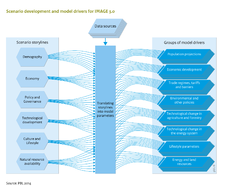Drivers/Scenario drivers: Difference between revisions
< Drivers
Jump to navigation
Jump to search
No edit summary |
Oostenrijr (talk | contribs) No edit summary |
||
| Line 18: | Line 18: | ||
Population data are used in energy and agricultural economics modelling, and in other IMAGE modules, such as [[Water|water stress]], [[Nutrients|nutrients]], [[Flood risks|flood risks]] and [[Human development|human health]]. | Population data are used in energy and agricultural economics modelling, and in other IMAGE modules, such as [[Water|water stress]], [[Nutrients|nutrients]], [[Flood risks|flood risks]] and [[Human development|human health]]. | ||
===Economy=== | |||
At the most aggregated level, economic activity is described in terms of gross domestic product (GDP) per capita. Models outside the IMAGE 3.0 framework, such as the [[OECD ENV-Growth model]], project long-term GDP growth based on developments in key production factors (e.g., capital, labour, natural resources), and the sector composition of the economy. The various components of GDP on the production side (in particular value added (VA) per sector) and expenditures (in particular private consumption) are estimated with more detailed models that take account of inter-sector linkages, own- and cross-price responses, and other factors [[Chateau et al., 2013]]. | |||
In IMAGE 3.0, economic variables are used as model drivers for the [[energy demand]] model , and non-agricultural water demand contributing to water stress, see ([[Water|Water model]]. To meet the requirements of the household energy demand model, average income is broken down into urban and rural population, and each population into quintiles of income levels. The latter is derived from the assumed uneven income distribution using the [[GINI]] factor, a measure of income disparity in a population. The macro indicator GDP per capita is also used directly in IMAGE components, such as [[human health]], [[flood risk]], and [[nutrients]] (for calculating urban wastewater). The agriculture model [[MAGNET]] is an economy-wide computable general equilibrium (CGE) model that reproduces exogenous GDP growth projections made in less complex economic growth models, see [[Agricultural economy]]. | |||
===Policy and governance=== | ===Policy and governance=== | ||
Revision as of 14:57, 16 June 2016
Parts of Drivers/Scenario drivers
| Projects/Applications |
| Models/Databases |
| Relevant overviews |
| Key publications |
| References |
